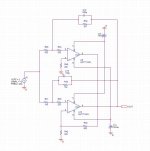Syn, Jan: Why do not you show your design invention in a single stage, extremely low noise, low distortion, fast and wideband circuit? Anyone can take 110dB FB and show great LF specs in a slow circuit.
chascode said:OT Jan, I enjoyed your interview of Eduardo de Lima in the new "Voice Coil".
Best, Chuck Hansen
/OT
Chuck, thank you. I've just done a lengthy one with Erno Borbely, I'm sure you'll like that as well.
Jan Didden
PMA said:Syn, Jan: Why do not you show your design invention in a single stage, extremely low noise, low distortion, fast and wideband circuit? [snip]
Pavel, I don't have one. That's why I ask about that circuit, I want to learn. Is that a problem?
Jan Didden
Just add an IC to this stage, feedback to the emitters. It is easy!
'Old John' I like that, thanks PMA!

'Old John' I like that, thanks PMA!
PMA said:There is a feedback and feedback. This has nothing to do with conventional dominant-pole VFB design. 57dB and 1.7MHz BW, no slew rate limitation. This counts.
We care how it sounds, not only how it measures THD in audio band.
"there is feedback and feedback" - that's the second best joke I've heard lately. The first is the Robert Heinlein quote: “Never try to teach a pig to sing; it wastes your time and it annoys the pig.”
And of course, when anything else fails, join the golden ear brigade team.
Wanna a circuit that has over 120dB OL gain, 100MHz unity gain OL bandwidth and is unconditionally stable for resistive loads? Take a look at the attachment. Now, try to figure out how it works, and what would it take to allow capactive loads (and hence make it useful for driving a power stage). Hint: you may still get over 120dB gain in the audio band, while limiting the BW at around 2 MHz.
Of course, this circuit sounds like crap 😀 It's built out of dirty sand and uses that "other" NFB that you dislike.
Attachments
PMA said:We care how it sounds, not only how it measures THD in audio band.
Yet to hear some talk, there's really no meaningful distinction between the two, and it ultimately just boils down to a numbers game.
se
john curl said:But, how quiet is it? NOISE is EVERYTHING with MC input.
Is it?
Is there no point below which it ultimately becomes meaningless?
If, at the listening position, and with no music playing, you cannot hear the noise being produced by the MC preamp, is the level of noise meaningful beyond a figure on a spec sheet?
se
john curl said:Please, a USEFUL question. Not a non-technical rant.
Oh. So these discussions have absolutely nothing to do with actually listening to reproduced music? It's really just a game of purely technical one-upmanship?
I rather suspected that it was. Thanks for removing any doubts I may have had.
se
Out of nothing else to do, let us take apart SE's question. How quiet is good enough? What is good enough for me, an old man? What about a young woman? What about a really low output MC cartridge like the original Ortofon cartridges, that this design was originally made for?
Why do you think that I chose 2 ohms as the input? That is the DCR of the Ortofon cartridge. Yes, it is the cartridge itself that sets the gain. What is the noise figure of this preamp with an Ortofon cartridge? Is it 3dB, 6dB, 10dB? Something else? Hint: With a 10 ohm cartridge, it is 3dB.
Why do you think that I chose 2 ohms as the input? That is the DCR of the Ortofon cartridge. Yes, it is the cartridge itself that sets the gain. What is the noise figure of this preamp with an Ortofon cartridge? Is it 3dB, 6dB, 10dB? Something else? Hint: With a 10 ohm cartridge, it is 3dB.

Please, a USEFUL question. Not a non-technical rant.
Mr. Curl, how to measure/see noise with ordinary DIY equipment (scope, signal generator, spectrum-soundcard)?
Please tell me when something interesting is to be discussed and solved again, I have no time for useless chat.
PMA, you should try the full differential version without caps, running about 2.5ma on each side.
- Status
- Not open for further replies.
- Home
- Amplifiers
- Solid State
- John Curl's Blowtorch preamplifier
